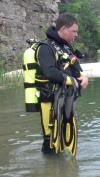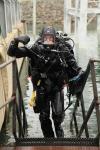
|
Greg - 5/21/2013 10:09 AM 
|
|

|
Awesome info thanks Greg!
|
|

|
Dang! 45 degrees in a 5mil??? That’s crazy! Here in SoCal we see temps in winter dip to around 48-54 degrees, and most can’t handle it with a 7mil, opting for a dry suit. I am considered a diver who runs hot. I sometimes dive in a 3mil during the summer when the water is in the upper 60’s. But I do start feeling the cold through my 7mil when the temp dips below 50. I’m not sure what the water temps are in the Mid West, but I’m sure someone will chime in soon. Dang!
|
|

|
I typically dive in 39 to 36 degree water but I also use a dry suit. I also use a 3 mil suit when the water temps get above 63 degrees. Not sure all this is helping you decide but dive in what you are comfortable in.
|
|

|
Thanks for all the replies! Quick question now that neoprene compression has been brought up, What’s the best way to compensate for neoprene compression without overheating at the surface and shallower waters. Should I buy a 3mm wetsuit? or just try a a deeper dive in what I have first and then see if compression is really and issue?
|
|

|
Are you using a Henderson Aqua Lock by any chance. Those things are as close to a dry suit as you can get in a standard wetsuit. I can see being able to get away with the 5mm if your dives aren’t to long or your depth isn’t to deep. Maybe a shorty for your core for those times you know the water is going to be colder because of the depth of the dive.
|
|

|
Greg - 5/22/2013 5:59 AM 
Wetsuits will compress the deeper you dive, which means you loose heat and buoyancy. That’s why we always teach to wear an exposure suit that will be comfortable at your diving depth. That may mean your more buoyant and hotter to start the dive, but once you reach your dive depth, you’ll be good.
Couple tips:
- Keep a bottle of water handy to keep cool. Pour it on your head or inside your wetsuit while your on land to cool down.
- Don’t get your wetsuit on until everyone is ready to get geared up and in the water.
- You may need to use a rope to pull yourself underwater the first 15 feet or so, until your wetsuit starts to compress and losses buoyancy. That way you’re not loaded down with a bunch of weight. Towards the end of the dive, you’ll have less air in your tank so that will help to balance out the buoyancy ad you ascend.
- As you are descending, be prepared to tap some air into the bc, due to buoyancy loss.
|
|

|
From Progrower: Are you using a Henderson Aqua Lock by any chance. Those things are as close to a dry suit as you can get in a standard wetsuit. I can see being able to get away with the 5mm if your dives aren’t to long or your depth isn’t to deep. Maybe a shorty for your core for those times you know the water is going to be colder because of the depth of the dive. I am not using and aqua-lock just a regular thermoprene. it usually lets a fair amount of water in however it gets warm fairly quick. As for the shorty, I think that’s what I’ll end up doing but probably give it a try without it for a first dive then rent a 3mm shorty from a dive shop for the second and see how it plays out. As far as time, the dives I’ve done between 45-50 degrees have been for at least 40 mins. Thanks for the great reply
|
|

|
From Greg: Wetsuits will compress the deeper you dive, which means you loose heat and buoyancy. That’s why we always teach to wear an exposure suit that will be comfortable at your diving depth. That may mean your more buoyant and hotter to start the dive, but once you reach your dive depth, you’ll be good. Couple tips: - Keep a bottle of water handy to keep cool. Pour it on your head or inside your wetsuit while your on land to cool down. - Don’t get your wetsuit on until everyone is ready to get geared u... Greg thank you for the good solid advice, now is there any way to predict neoprene compression at a specific depth, is there any "easy" solution for my dilemma? The reason i ask is right now I have some extra money I can use to buy some more wetsuit components however when I get to Kentucky that extra money stops being extra. Again thanks for the reply and help.
|
|

|
From Greg: You may need to use a rope to pull yourself underwater the first 15 feet or so, until your wetsuit starts to compress and losses buoyancy. That way you’re not loaded down with a bunch of weight. Towards the end of the dive, you’ll have less air in your tank so that will help to balance out the buoyancy ad you ascend.
Good luck with that safety stop when that aluminum tank is closing in on 500 psi.;)
|
|

|
Greg - 5/22/2013 5:31 PM 
From Eekthor: is there any way to predict neoprene compression at a specific depth
It’s not easy. Depends on thickness of the suit and consistency of air bubbles in the neoprene. I don’t know of any calculations or charts for this. But you really don’t need to go that deep into the issue. You’ve already proven you can handle the cold temp with the wetsuit you have. And you can adjust for buoyancy loss by adjusting your weight and air in BC.
If you have some money to spend now, you might want to consider a 3mm shorty. That way you can comfortably dive in a little warmer water.
|
|

|
If you can handle 45 in 5mil you’re a better man then me.
Generally speaking quarries warm quite a bit as the season goes on.
Last August we were able to dive our local quarry (Dutch Springs) in 1/2 mil
suits as long as we keep it to 35’.
Most people dive dry or 7 mil wet. Buoyancy is tough with 7 mil until you get used to it.
i would stay with the 5 mil if you find it warm enough
|
|

|
Hey,
I dive the IL, KY, and TN quarries all year and just got my first 7mm this past Christmas so I’ve also been a 5mm diver up until now. The water temps in the dead of winter will dip into the low to mid 40’s in some of the quarries so you’ll be fine based on the water temps you are used to already.
Hit me up when you get to Clarksville and I’ll be happy to hook up with you and show you the diving in the area.
Michael
|
|

|
Thank you all for the replies. Michael, I will hit you up for sure once I get there.
|
|

|
Take a dry suit class and you’ll never dive a wet suit in a quarry again. Hardcore or not, recommendation is the any temp below 60, use a dry suit. Nitrogen Narcosis can also creep up on you faster during deep dives when is cold.
|
|